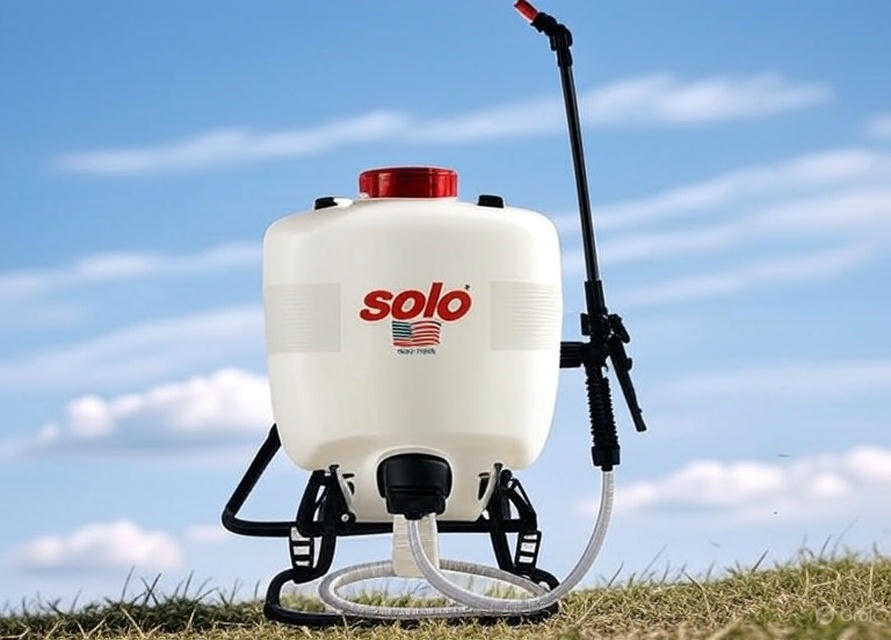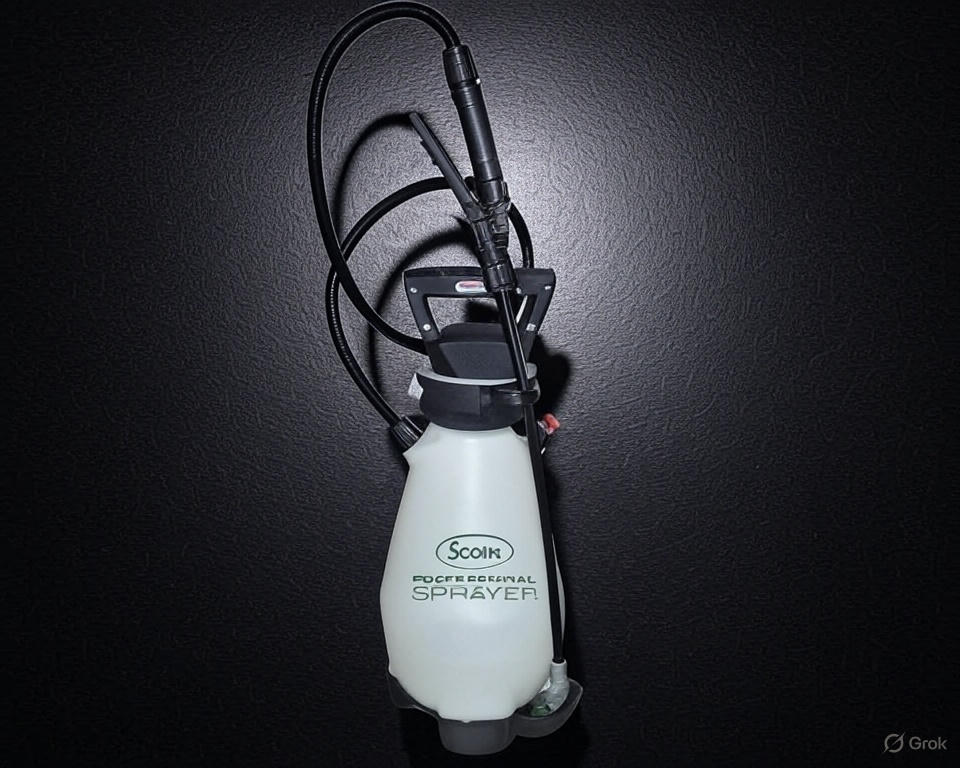Maintaining a healthy and vibrant lawn requires more than just regular watering and mowing; controlling pests is essential to protect your grass from damage. Insecticide lawn sprayers play a crucial role in distributing insecticides evenly across your lawn, targeting pests like ants, mosquitoes, and grubs that can wreak havoc on your outdoor space. Whether you’re dealing with a small yard or a large landscape, choosing the Best Insecticide Lawn Sprayer ensures effective pest control and helps maintain the overall health of your lawn. In this article, we’ll explore the different types of insecticide lawn sprayers, key factors to consider when choosing one, and the best products available to suit various needs.
Contents
Types of Lawn Sprayers
When it comes to applying insecticides on your lawn, different types of sprayers cater to various needs based on the size of your lawn, the ease of use, and the type of insecticide. Here’s an overview of the most common types of lawn sprayers:
Hose-End Sprayers
Hose-end sprayers are attached directly to your garden hose, automatically diluting the insecticide as water flows through the system. These are great for small to medium-sized lawns due to their ease of use and convenience.
- Best for: Quick and even coverage over medium lawns.
- Pros: Easy to set up, no manual pumping required, affordable.
- Cons: Limited control over dilution and spray precision.
Pump Sprayers
Pump sprayers are manual devices that allow you to pressurize the tank by pumping, then release a fine mist of insecticide through a nozzle. These are ideal for spot treatments or smaller areas where precision is necessary.
- Best for: Spot treatment and targeted spraying.
- Pros: Good control over spray pattern and pressure, affordable.
- Cons: Requires manual pumping, not suitable for large lawns.
Backpack Sprayers
Backpack sprayers are worn on your back, allowing for greater mobility and capacity, making them suitable for larger lawns or extensive pest control needs. They come in manual and battery-powered options.
- Best for: Large lawns and long spraying sessions.
- Pros: Large capacity, hands-free operation, more efficient for covering big areas.
- Cons: Can be heavy when filled, may require practice to use comfortably.
Battery-Powered Sprayers
Battery-powered sprayers automate the spraying process, eliminating the need for manual pumping. They provide a consistent and steady spray, ideal for those who want efficiency without the physical effort.
- Best for: Large lawns or users who prefer convenience.
- Pros: No manual pumping, consistent spray output, time-saving.
- Cons: More expensive, requires battery maintenance.
Each of these sprayers has unique benefits and limitations, so selecting the right one depends on the size of your lawn, the type of insecticide you’re using, and your comfort with manual or automated tools.
Key Factors to Consider When Choosing a Lawn Sprayer
Choosing the right lawn sprayer can make a significant difference in how effectively you control pests and maintain the health of your lawn. Here are some important factors to consider when selecting a lawn sprayer:
Coverage Area
- The size of your lawn determines the sprayer’s capacity and type. For small yards, a handheld pump sprayer may be sufficient, while larger lawns may require a backpack or battery-powered sprayer for efficient coverage.
Ease of Use
- Look for a sprayer that is user-friendly, lightweight, and comfortable to handle. Consider ergonomic designs, especially if you’ll be using the sprayer for extended periods. Sprayers with adjustable nozzles and easy-to-fill tanks are more convenient.
Durability and Build Quality
- Choose a sprayer made from high-quality materials like durable plastic or stainless steel to ensure it lasts and can handle chemical exposure. A well-built sprayer will withstand regular use and resist corrosion from harsh insecticides.
4. Adjustability and Nozzle Options
- Different lawns and pest issues require different spray patterns (fine mist, stream, or fan spray). Choose a sprayer with adjustable nozzles or multiple nozzle options to control the flow and coverage based on your lawn’s needs.
Power Source
- Consider whether you prefer a manual (pump or hose-end) sprayer or a powered option (battery or electric). Manual sprayers are cost-effective but may require more effort, while powered sprayers offer efficiency and ease of use for larger jobs.
Portability and Weight
- For larger lawns, a lightweight and portable sprayer is key. Backpack sprayers are excellent for mobility, but ensure the weight when filled is manageable. Wheeled or battery-powered models are also good for reducing physical strain.
Budget
- Sprayers vary widely in price, from budget-friendly options to high-end models with advanced features. While it’s important to consider your budget, don’t compromise on quality. A higher-quality sprayer often leads to better performance and longevity.
Maintenance and Cleaning
- Some sprayers are easier to clean and maintain than others. Look for sprayers with detachable parts for easy cleaning, and ensure the material can withstand exposure to various chemicals without degrading.
Top Insecticide Lawn Sprayer
PetraTools 1 Gallon Pump Sprayer – HD101 Garden Sprayer
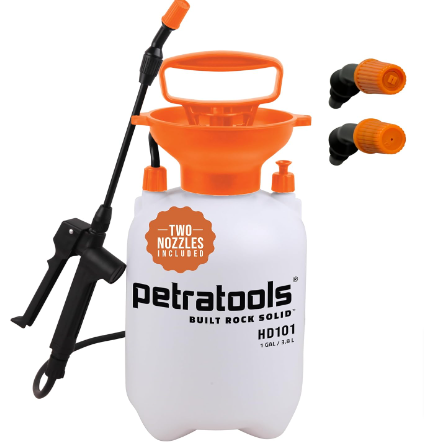
The PetraTools 1 Gallon Pump Sprayer (HD101) is a versatile and user-friendly garden tool designed for various outdoor applications, including spraying insecticides, herbicides, and water. It is particularly suitable for homeowners who need a reliable sprayer for small to medium-sized lawns, gardens, or plants. Below are the key features and benefits of this sprayer:
Key Features
- 1-Gallon Capacity: Ideal for small lawns, flower beds, and garden plants. This size offers enough capacity for most household spraying needs without being too bulky or heavy.
- Heavy-Duty Design: The HD101 model is built with durability in mind, featuring a strong plastic tank that resists chemicals and impact, ensuring long-lasting use.
- 2 Adjustable Nozzles: The sprayer comes with two nozzles for different spray patterns—one for a fine mist and the other for a more direct stream. This makes it suitable for both broad coverage and targeted spot treatments.
- Manual Pump Pressure: The sprayer operates using a hand-pumped pressurization system. This allows for easy pressure buildup to spray evenly without requiring any external power source.
- Comfortable Handle and Ergonomic Design: The handle is designed for ease of use, allowing comfortable pumping and spraying. The compact size and lightweight build make it easy to carry around the yard.
Pros
- Versatile Use: Can be used for insecticides, herbicides, and watering plants, making it a multi-purpose tool for garden care.
- Durable Build: The heavy-duty plastic material ensures the sprayer can handle various chemicals without corroding or leaking.
- Adjustable Nozzles: The inclusion of two different nozzles gives users flexibility in their spraying needs.
- Affordable: This sprayer provides good value for money, especially for homeowners looking for a reliable yet cost-effective solution.
Cons
- Manual Pumping Required: Since it’s a manual pump sprayer, users need to apply effort to pressurize the tank, which can be tiring for larger jobs or long periods of use.
- Limited Capacity: The 1-gallon size may not be sufficient for large lawns or extended projects, requiring frequent refills.
Best For
- Homeowners with small to medium-sized gardens or lawns.
- Those looking for an affordable, durable, and versatile sprayer for general gardening tasks.
- People who need a compact, lightweight sprayer for spot treatments or smaller coverage areas.
The PetraTools 1 Gallon Pump Sprayer (HD101) is an excellent choice for those seeking a cost-effective and durable garden sprayer. Its versatility, along with the two adjustable nozzles, makes it suitable for a wide range of applications, from spraying insecticides to watering plants. While it requires manual pumping and has a limited capacity, it offers great value for smaller jobs and household garden care.
Flo-Master by Hudson 24101 1 Gallon Lawn and Garden Tank Sprayer
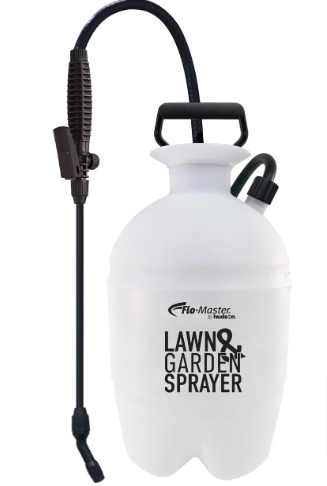
The Flo-Master by Hudson 24101 1 Gallon Lawn and Garden Tank Sprayer is a practical and affordable tool designed for various lawn and garden applications. This sprayer is ideal for small to medium-sized outdoor areas and can be used for applying insecticides, herbicides, or water to plants. Here’s a breakdown of its features, benefits, and potential drawbacks:
Key Features
- 1-Gallon Translucent Tank: The 1-gallon capacity is suitable for small lawns or gardens, offering enough volume for most routine gardening tasks. The translucent tank allows for easy monitoring of liquid levels, so you can see when it’s time to refill.
- Polyethylene Construction: Made from durable, lightweight polyethylene plastic, this sprayer is designed to resist corrosion from chemicals, ensuring long-lasting performance.
- Adjustable Cone Nozzle: The sprayer features an adjustable nozzle that provides a range of spray patterns, from a fine mist to a steady stream, offering flexibility for different tasks.
- Easy-to-Use Pump System: The manual pump pressurizes the tank for consistent spraying, giving you control over the pressure and application.
- Pressure Relief Valve: This safety feature allows you to release pressure from the tank before opening it, which prevents accidental sprays and ensures safe operation.
Pros
- Affordable: The Flo-Master 24101 is budget-friendly, making it a great option for those who need a basic, reliable sprayer without spending too much.
- Easy Liquid Level Monitoring: The translucent tank allows users to quickly check how much solution is left, making refills more predictable.
- Adjustable Spray Patterns: The nozzle allows you to switch between different spray patterns depending on the application, which adds versatility.
- Lightweight and Portable: The compact design makes it easy to carry around, and the manual operation doesn’t require any external power source.
Cons
- Limited Capacity: The 1-gallon size is perfect for small tasks but may require frequent refills for larger areas or more extensive jobs.
- Manual Pumping: As a hand-pump sprayer, it requires effort to maintain pressure, which can be tiring during longer or more demanding projects.
- Basic Design: While effective, the sprayer doesn’t offer advanced features that higher-end models might include, such as multiple nozzle attachments or a larger capacity.
Best For
- Gardeners with small lawns or flower beds who need a cost-effective solution for applying insecticides, herbicides, or water.
- Homeowners looking for a lightweight, portable sprayer for occasional use.
- Users who prefer a simple, no-frills sprayer for general gardening tasks.
The Flo-Master by Hudson 24101 1 Gallon Lawn and Garden Tank Sprayer is a solid choice for those seeking a simple, reliable sprayer for everyday garden maintenance. Its affordable price, lightweight design, and adjustable nozzle make it well-suited for small lawn care tasks. However, it may not be ideal for larger gardens or extended use due to its limited capacity and the need for manual pumping. If you’re looking for a basic sprayer to tackle small jobs, the Flo-Master 24101 offers good value for money.
Chapin 20075 Disinfectant Bleach Sprayer – 1 Gallon
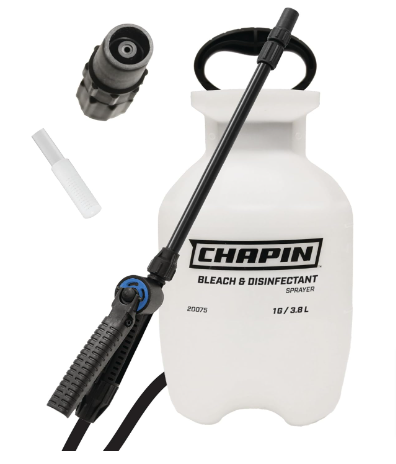
The Chapin 20075 Disinfectant Bleach Sprayer is a versatile 1-gallon sprayer designed specifically for use with disinfectant and bleach solutions, making it ideal for cleaning, sanitizing, and pest control in outdoor and indoor settings. Built with durability in mind, this sprayer offers features that cater to both residential and commercial needs. Here’s an overview of its key attributes, advantages, and any potential limitations.
Key Features
- 1-Gallon Translucent Tank: The sprayer features a 1-gallon capacity, making it suitable for small to medium tasks. The translucent white tank allows for easy monitoring of liquid levels, helping you keep track of how much solution is left.
- Bleach and Fungicide Compatible: This sprayer is specifically designed to handle bleach solutions, fungicides, and other disinfectants, ensuring safe application without corroding the internal components.
- Adjustable Cone Nozzle: The adjustable nozzle allows users to control the spray pattern, offering a range from a fine mist to a direct stream. This adjustability makes it ideal for different application needs, from broad surface coverage to spot treatments.
- Durable Construction: Made in the USA, the sprayer is built with high-quality materials that resist chemical wear and corrosion, making it perfect for harsh cleaning agents like bleach.
- Easy-to-Use Pump Mechanism: The manual pump creates the necessary pressure to distribute liquids effectively, ensuring even application with minimal effort.
- Pressure Relief Valve: A safety feature that lets you release pressure from the tank before opening it, preventing any accidental splashes or sprays.
Pros
- Bleach-Compatible: Specifically designed to handle bleach solutions, making it ideal for disinfecting surfaces or cleaning outdoor spaces safely without damaging the sprayer.
- Adjustable Nozzle: The nozzle allows for a range of spray patterns, making the sprayer versatile for different applications, from sanitizing larger areas to targeted spraying of fungicides.
- Durable Build: Constructed with high-quality materials that resist corrosion, especially important when working with bleach or strong chemicals.
- Translucent Tank: The translucent tank makes it easy to check liquid levels, ensuring you know when it’s time to refill.
- Made in the USA: Proudly manufactured in the USA, ensuring quality control and craftsmanship.
Cons
- Manual Pumping: Like most manual sprayers, the Chapin 20075 requires hand-pumping to pressurize the tank, which may become tiring over long periods or for larger areas.
- Limited Capacity for Large Areas: While 1 gallon is great for small to medium jobs, larger spaces may require frequent refilling, which could be inconvenient for extended use.
- Specific Use: While great for bleach and disinfectants, its design may not be as versatile for general garden spraying if you need to switch between multiple chemicals frequently.
Best For
- Homeowners and professionals who need a sprayer specifically designed for use with disinfectants, bleach solutions, or fungicides.
- Disinfecting and cleaning surfaces in outdoor spaces, such as patios, walkways, or outdoor furniture.
- Small to medium-sized lawn and garden pest control tasks involving fungicides or weed killers.
The Chapin 20075 Disinfectant Bleach Sprayer is an excellent choice for those looking for a reliable and durable sprayer to handle bleach, disinfectants, and fungicides. Its high-quality construction ensures long-term use, even when exposed to harsh chemicals. The adjustable nozzle offers flexibility in spraying, and the translucent tank allows for easy monitoring of solution levels. While it may require manual effort and frequent refills for larger areas, it’s a well-designed and effective tool for homeowners and professionals who need a dedicated sprayer for disinfecting and pest control tasks.
Scotts 2 Gallon Lithium-Ion Battery Powered Sprayer with Pump Zero Technology – Model 190567
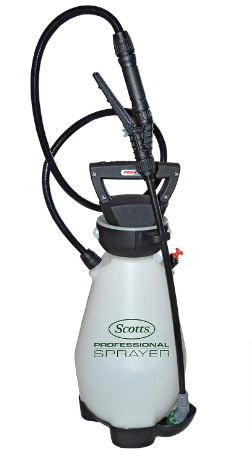
The Scotts 2 Gallon Lithium-Ion Battery Powered Sprayer (Model 190567) is a premium lawn and garden sprayer designed for users who prefer convenience and efficiency. With its rechargeable battery and Pump Zero technology, this sprayer eliminates the need for manual pumping, making it an ideal choice for those looking to tackle larger lawn and garden projects with minimal effort. Below is an in-depth review of its features, pros, cons, and ideal uses.
Key Features
- 2-Gallon Capacity: The 2-gallon tank provides ample capacity for medium to large lawns and garden areas, reducing the need for frequent refills during application.
- Lithium-Ion Battery Powered: This sprayer is equipped with a rechargeable lithium-ion battery, allowing for continuous spraying without the need to manually pump for pressure. The battery provides hours of consistent spraying on a single charge.
- Pump Zero Technology: The advanced Pump Zero technology ensures even and consistent spray output with no manual pumping, making it much more convenient for extended use.
- 21-Inch Poly Wand: The long, durable wand provides greater reach and precision, allowing you to spray in hard-to-reach areas, such as under plants or along fences.
- 3-In-1 Nozzle: The sprayer features a 3-in-1 nozzle with adjustable settings for different spray patterns, including fan, stream, and cone options. This versatility makes it suitable for a wide range of applications, from broad coverage to targeted spraying.
- Rechargeable Battery: The included lithium-ion battery is rechargeable, allowing for extended use without replacing batteries. This feature also makes it eco-friendly and cost-effective in the long run.
Pros
- No Manual Pumping: One of the biggest advantages is the battery-powered pump system, which eliminates the need for manual pumping, saving time and effort, especially on larger projects.
- Consistent Spray Pressure: The Pump Zero technology provides a steady, consistent spray, which is particularly helpful for even coverage across larger lawns or garden areas.
- Adjustable Spray Patterns: With the 3-in-1 nozzle, you can easily switch between different spray patterns, making the sprayer versatile enough for different tasks, including pest control, fertilizing, and watering.
- Long Battery Life: The lithium-ion battery offers extended usage time, allowing you to complete most spraying tasks without needing to recharge frequently.
- Durable and Lightweight Design: Despite the added battery and wand features, the sprayer remains lightweight and easy to carry around the yard.
Cons
- Higher Price: As a battery-powered sprayer, it comes at a higher cost compared to traditional manual sprayers. The additional convenience of the pump-free technology may be worth the investment for frequent users, but casual gardeners may find it unnecessary.
- Battery Maintenance: The battery needs to be recharged and maintained, which could be inconvenient for users who prefer low-maintenance tools.
- Weight When Full: With a 2-gallon capacity, the sprayer can become heavy when fully loaded, which may make it less comfortable to carry for longer periods.
Best For
- Homeowners with medium to large lawns or gardens who need a convenient and efficient solution for applying insecticides, herbicides, fertilizers, or water.
- Users who prefer a hands-free, automated sprayer that minimizes physical effort.
- Gardeners who frequently treat their lawns or gardens and would benefit from the time-saving, battery-powered design.
The Scotts 2 Gallon Lithium-Ion Battery Powered Sprayer (Model 190567) is a highly convenient and efficient tool for those looking to eliminate the hassle of manual pumping. With its Pump Zero technology and rechargeable lithium-ion battery, it offers consistent and steady spraying with minimal effort. The adjustable nozzle allows for versatile use across different lawn and garden tasks, making it a great choice for homeowners with medium to large areas to cover. While it comes at a higher price point and requires battery maintenance, the added convenience and efficiency make it a worthwhile investment for those who need a reliable sprayer for frequent use.
Smith Performance Sprayers 190285 1-Gallon Bleach and Chemical Sprayer:
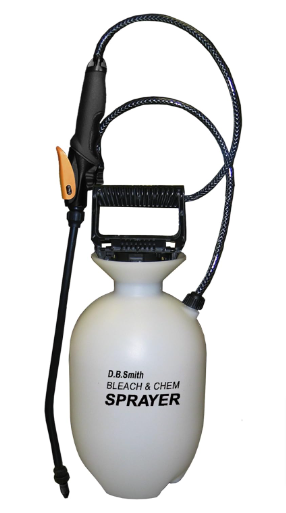
The Smith Performance Sprayers 190285 1-Gallon Bleach and Chemical Sprayer is a durable and versatile sprayer designed for both lawn and garden care as well as cleaning applications. It is specifically built to handle harsh chemicals like bleach and other disinfectants, making it ideal for outdoor cleaning tasks and pest control. Here’s a breakdown of its key features, benefits, and any potential limitations.
Key Features
- 1-Gallon Capacity: The sprayer has a 1-gallon tank, which is suitable for small to medium jobs, whether you’re using it for lawn care or cleaning tasks. This size offers a balance between portability and sufficient capacity for various applications.
- Bleach and Chemical Resistant: Built with Viton seals and gaskets, the sprayer is designed to withstand harsh chemicals like bleach, disinfectants, fungicides, and herbicides, making it safe and durable for cleaning or pest control tasks without risk of damage or leaks.
- Adjustable Poly Nozzle: The sprayer features an adjustable poly nozzle that allows for different spray patterns, ranging from a fine mist to a direct stream. This adjustability is useful for both large surface applications (like cleaning decks or siding) and more targeted spraying (like garden pest control).
- Pressure Release Valve: Equipped with a pressure release valve, the sprayer allows you to safely release built-up pressure before opening the tank, preventing accidents and ensuring safe operation.
- Heavy-Duty Design: Made from professional-grade materials, the 190285 model is designed for durability. It can handle repeated use with bleach and chemicals without corroding or breaking down.
- Comfortable Grip and Handle: The ergonomic design of the handle makes it easy to pump and spray, reducing hand fatigue during longer tasks.
Pros
- Chemical Resistant: The Viton seals and gaskets make this sprayer highly resistant to chemicals, especially bleach, ensuring long-term durability even when used with corrosive substances.
- Adjustable Spray Pattern: The adjustable nozzle provides flexibility in applying different types of chemicals, whether you need a broad mist for large areas or a direct stream for spot treatment.
- Multi-Use: Versatile for both lawn and garden care, as well as cleaning decks, siding, concrete, and other outdoor surfaces, this sprayer is suitable for homeowners who need a tool for multiple tasks.
- Durable Construction: Made with heavy-duty materials, the sprayer is built to last, even with frequent use and exposure to strong chemicals.
- Pressure Release Valve: Ensures safety by allowing pressure to be released before opening the tank, reducing the risk of chemical exposure or accidental sprays.
Cons
- Manual Pumping: Like most manual sprayers, it requires pumping to pressurize the tank, which may become tiring during extended use or larger tasks.
- Limited Capacity: The 1-gallon tank is sufficient for small to medium jobs, but for larger areas or longer tasks, it may require frequent refilling.
- Heavy When Full: Though compact, the sprayer can become relatively heavy when filled with chemicals, which may be uncomfortable for some users during prolonged use.
Best For
- Homeowners or professionals who need a durable, chemical-resistant sprayer for disinfecting, cleaning, and pest control.
- Users who need a versatile sprayer for both lawn care and outdoor cleaning tasks, such as cleaning decks, siding, and concrete surfaces.
- Those looking for a reliable, bleach-compatible sprayer for small to medium projects.
The Smith Performance Sprayers 190285 1-Gallon Bleach and Chemical Sprayer is an excellent tool for those who need a tough, chemical-resistant sprayer for both lawn care and cleaning tasks. Its durable construction, adjustable nozzle, and chemical-resistant materials make it ideal for applying harsh chemicals like bleach, fungicides, and herbicides without worrying about corrosion or leaks. While the need for manual pumping and the limited capacity may not make it ideal for large-scale projects, its versatility and durability make it a solid choice for smaller tasks or regular maintenance work.
How to Properly Use a Lawn Sprayer for Insecticides
Using a lawn sprayer for insecticides requires precision and care to ensure the safety of both the user and the environment while effectively treating your lawn. Follow these steps for the proper use of a lawn sprayer to apply insecticides:
Choose the Right Equipment
- Select the Appropriate Sprayer: Choose a sprayer suitable for the size of your lawn and the type of insecticide you are using. Handheld or pump sprayers work well for smaller areas, while backpack or battery-powered sprayers are ideal for larger lawns.
- Nozzle Type: Ensure your sprayer has an adjustable nozzle to control the spray pattern, allowing for even coverage without over-application.
Read and Understand the Label
- Insecticide Instructions: Always read the label on the insecticide product carefully. It will provide important information, including mixing ratios, application rates, and safety precautions.
- Personal Protective Equipment (PPE): Follow the label’s safety instructions regarding PPE. Wear gloves, long sleeves, eye protection, and a mask to avoid skin contact or inhalation of harmful chemicals.
Mix the Insecticide Properly
- Measure Accurately: Use the exact amount of insecticide as indicated by the product label. Overuse can harm your lawn and the environment, while underuse may be ineffective.
- Fill the Tank with Water: Before adding the insecticide, fill the sprayer tank halfway with water to help the mixture dissolve evenly.
- Add the Insecticide: Add the insecticide to the water in the tank, then top off the tank with the remaining water. Close the sprayer tightly and shake it gently to ensure the solution is mixed thoroughly.
Apply the Insecticide
- Target the Right Areas: Focus on areas where insects are most prevalent, such as around the base of plants, along edges, and in shaded areas where pests thrive.
- Even Spraying: Hold the sprayer nozzle at a consistent height, typically 1-2 feet from the ground, and spray evenly in a sweeping motion. Avoid over-saturating any single area.
- Apply During Ideal Conditions: Spray during calm, cool mornings or late afternoons to reduce the chance of wind drift and evaporation. Avoid spraying during rain or immediately before a rainstorm, as the insecticide can wash away.
Clean and Maintain Your Sprayer
- Rinse Thoroughly: After using the sprayer, rinse the tank, wand, and nozzle thoroughly with water to remove any remaining insecticide residue. This prevents chemical buildup and extends the life of your sprayer.
- Store Safely: Store the sprayer in a cool, dry place away from direct sunlight and out of reach of children and pets.
Safety Precautions
- Keep Pets and People Away: Keep children, pets, and other people away from the treated area until the insecticide has fully dried.
- Dispose of Leftover Chemicals Properly: Dispose of any leftover insecticide solution according to local regulations. Never dump chemicals down drains or into the soil.
Frequently Asked Questions (FAQs) about Using Lawn Sprayers for Insecticides
1. What type of lawn sprayer should I use for insecticides?
- Answer: The type of sprayer you choose depends on the size of your lawn and the specific insecticide you’re using. Handheld or pump sprayers are suitable for small areas, while backpack or battery-powered sprayers are ideal for larger lawns. Ensure the sprayer has an adjustable nozzle for different spray patterns.
2. How do I mix insecticides properly?
- Answer: Always follow the manufacturer’s instructions on the product label for mixing ratios. Generally, fill the sprayer tank halfway with water, add the recommended amount of insecticide, then top off the tank with more water. Mix gently by shaking or stirring to ensure an even solution.
3. When is the best time to apply insecticides?
- Answer: The best times to apply insecticides are early in the morning or late in the afternoon when temperatures are cooler and winds are calmer. Avoid applying during windy conditions or before rain, as this can lead to ineffective treatments and runoff.
4. How can I ensure even coverage when spraying?
- Answer: To achieve even coverage, hold the sprayer nozzle consistently at a height of about 1-2 feet from the ground. Use a sweeping motion, overlapping each pass slightly to avoid missed spots.
5. Are there safety precautions I should take while spraying insecticides?
- Answer: Yes, always wear appropriate personal protective equipment (PPE), such as gloves, goggles, and a mask. Keep people and pets away from treated areas until the insecticide has dried. Always read the label for specific safety instructions related to the product you’re using.
6. How do I clean my sprayer after use?
- Answer: After using the sprayer, rinse the tank, wand, and nozzle thoroughly with water to remove any remaining chemical residue. Fill the tank with clean water and spray until the solution runs clear. This prevents chemical buildup and prolongs the life of your sprayer.
7. What should I do if I accidentally spray myself?
- Answer: If you accidentally spray insecticide on yourself, immediately wash the affected area with soap and water. Follow the first aid instructions provided on the insecticide label. If irritation persists or you experience any adverse reactions, seek medical attention.
8. Can I use a lawn sprayer for other types of chemicals?
- Answer: Yes, many lawn sprayers can be used for a variety of chemicals, including herbicides, fungicides, fertilizers, and even water. However, be sure to clean the sprayer thoroughly after each use to prevent chemical contamination.
9. How often should I apply insecticides to my lawn?
- Answer: The frequency of insecticide application depends on the type of insects you’re targeting and the specific product you’re using. Always follow the manufacturer’s recommendations for application intervals to ensure effectiveness and prevent harm to beneficial insects.
10. What should I do with leftover insecticide?
- Answer: Dispose of any leftover insecticide according to local regulations. Never pour chemicals down the drain or into the soil. Many communities have specific disposal sites or events for hazardous materials, so check with your local waste management authorities.
Conclusion
Using a lawn sprayer for insecticides is an effective way to maintain a healthy and pest-free yard. By selecting the right equipment, following proper mixing and application techniques, and adhering to safety precautions, you can ensure that your spraying is both efficient and safe. Whether you’re targeting specific pests or managing broader infestations, understanding the ins and outs of your sprayer and the insecticides you use will maximize results while minimizing risks to yourself, your plants, and the environment.
Regular maintenance and cleaning of your sprayer will enhance its lifespan and performance, allowing you to tackle your lawn care tasks with confidence. Armed with the knowledge from this guide, you can effectively manage insect populations in your garden, leading to a thriving and vibrant outdoor space. Remember, a little preparation and care can go a long way in achieving a lush, pest-free lawn.
References
- U.S. Environmental Protection Agency (EPA). (n.d.). Pesticide Safety Education Program. Retrieved from EPA Pesticide Safety
- University of California Agriculture and Natural Resources. (2020). Using Sprayers for Insecticides. Retrieved from UC ANR Pest Management
- Penn State Extension. (n.d.). Proper Use of Pesticides: Sprayers and Spraying Techniques. Retrieved from Penn State Extension
- North Carolina State University. (n.d.). Home and Garden Pesticide Safety. Retrieved from NCSU Pesticide Safety
- University of Georgia Cooperative Extension. (2021). A Guide to Home Lawn Insecticides. Retrieved from UGA Extension
- Smith Performance Sprayers. (n.d.). How to Properly Use a Sprayer for Insecticides. Retrieved from Smith Performance Sprayers




